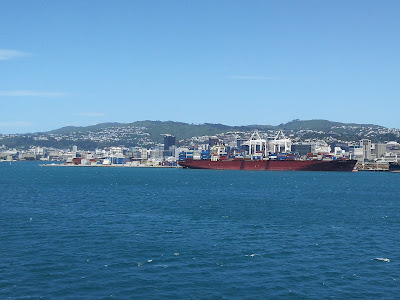December 24th, 2019
On the recommendation of Braden, and from some of the research
I’d done, I booked the Tongariro Alpine
Crossing, rated as one of the best one day hikes in New Zealand and also the
world. I had heard about the hike when I
was at Mt. Taranaki, its sister volcano about 200 kilometres away, but didn’t
know much about it. I decided to do it
on Christmas Day, figuring it might be pretty quiet plus it just lined up with
my itinerary.
So I set out from Castlepoint for a 3-4 hour drive to a
campsite called Mangahuia near the mountain.
A few hours into my drive I stopped at a viewpoint which was a bit
different than your usual viewpoint.
Sure, it had a nice view of valleys on either sides of the small ridge I’d
driven up, but it was a windfarm. Te Apiti
is one of the first windfarms in New Zealand with 55 wind turbines generating
enough electricity to power 30,000 homes.
The cool thing was that you could walk right up to the base
of the turbine…I’ve never been so close to one, nor had I heard the whooshing
sound made by each blade as it passed by its lowest point in its rotation. If you followed one of the blade tips with
your eyes for a couple of rotations, you could tell that those things were
really moving! Ironically, I had just
read a news article online about Donald Trump complaining about windmill farms
with ridiculous claims such as the harm of toxic fumes released into the atmosphere
during their manufacturing and that they created “bird graveyards” beneath them…what
a dolt. Anyways, I thought it was a cool
experience.
Whoosh, whoosh, whoosh...
About 50 kilometres from my destination I passed a sign
saying “Tangiwai Disaster Memorial”. I didn’t
know what is was about and continued on for a few more kilometres before I
decided to look it up on my phone. Turns
out it was a railway accident that happened on Christmas Eve of 1953. Shit, it’s Christmas Eve today, I must go
check it out.
I backtracked and pulled into the parking area of the
memorial. There were a few covered shelters
with information boards, a monument and the number plate from the locomotive. Only one other car was in the parking lot
with a gentleman leaning up against the hood of his car. I thought I saw him wipe his eyes before
sitting back in his car and remaining there for another 10 minutes. I wondered whether he was here to remember a
lost family member, but it was a fairly long time ago and he looked like he
would have just been born around that time, but it still is plausible.
The locomotive engine plate:
What happened was a train from the capital city of Wellington
was headed to Auckland, chock full with people going to spend Christmas with
loved ones. A lahar let loose and smashed
out the railway and nearby road bridge.
I hadn’t heard of a “lahar” before, and likely you haven’t either. Well a lahar is, thanks to Wikipedia, a violent
type of mudflow or debris flow composed of a slurry of pyroclastic material,
rocky debris and water. There are a
number of different ways that a lahar can happen but just think of it as a dam
bursting of built-up water, rocks, debris and perhaps lava up on a volcano
which flows rapidly and violently downhill.
Where it happened:
The memorial:
In this case an eruption in 1945 emptied a lake, very
originally named “Crater Lake”, and then dammed it up with volcanic rock. The lake refilled with water and eventually
broke the natural dam and all hell broke loose in 1953. The rush of water and debris smashed the railroad
bridge and a road bridge just after 10 pm.
A motorist named Cyril Ellis stopped his car just short of the washed
out bridge on the highway. Upon hearing and
then seeing the light of an oncoming train on the tracks nearby, he rushed out
to the railway and frantically waved his flashlight.
The engineer slammed on the brakes and his fireman shut off
the oil supply to the fire but it was too late.
The train slowed but the locomotive flew off the edge and smashed into
the bank on the other side of the river.
The tender and five second class cars flew into the river and a sixth
dangled precariously from the tracks.
The crashing sound was heard up to 15 kilometres away.
Unfortunately, 151 people perished although 134 survived,
some thanks to the heroic efforts of people like Cyril (the guy waving his flashlight)
who helped pull people out of the dangling railcar before the couplings gave
way and it plunged into the river. It
still remains as New Zealand’s worst railway disaster.
Tangiwai ironically means “Weeping Waters” in Maori. It must have been a very sad Christmas for
many people that year, and for years to come.























































